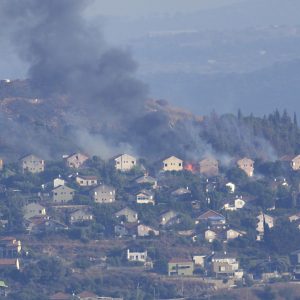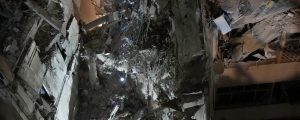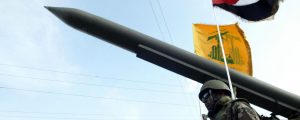Tensions between Israel and Lebanon’s Hezbollah have been on a knife’s edge since October 2023, with skirmishes, airstrikes, rocket and drone attacks displacing nearly 200,000 civilians. Israeli threats to kick off a major offensive and the assassination of a senior Hezbollah commander this week threaten to plunge the region into a full-scale war.

Settlers forced to flee the scenic hills and valleys of northern Israel near the border with Lebanon fear they may never be able to return amid intensifying clashes between the Israeli Defense Forces and Hezbollah which have made some settlements virtually unlivable.
“For the last 17 years we thought we lived in Tuscany,” Nisan Zeevi, the resident of a kibbutz less than 2 km from the border with Lebanon, told the Financial Times.
“But when missiles started shooting from Lebanon, all of a sudden we realized that with all due respect to the start-ups, the innovation, climate tech, food tech, agtech, we live in the f*cking Middle East. And we had forgotten about this,” Zeevi said.
Wide swathes of northern Israel were evacuated late last year after the uptick in fighting with Hezbollah, with approximately 95,000 civilians in Israel and, and a similar number in Lebanon internally displaced, and at least 25 civilians in Israel and the occupied Golan Heights, 104 Lebanese and 21 Syrians, killed in clashes.
Hundreds of Hezbollah fighters and IDF troops have also died. Israel mounted the largest evacuation in its 76-year history last year amid the uptick in fighting in the north, with about 50,000 remaining evacuated and dependent on government support, living in hotels or with relatives.
Israel Prime Minister Benjamin Netanyahu has been threatening to mount an “extremely powerful” operation against Hezbollah since early June.
Last month, an attack killed over a dozen people in a Druze community in the occupied Golan Heights, sparking a new round of escalation, with the Israeli Army shelling 15 settlements in eastern and southern Lebanon, and assassinating senior Hezbollah commander Fuad Shukr, prompting Hezbollah leader Hassan Nasrallah to warn that Israel will be made to “weep” for its actions.
 Civil defense workers check for victims between the wreckage of destroyed buildings that were hit by an Israeli airstrike in the southern suburbs of Beirut, Lebanon – Sputnik International, 1920, 01.08.2024
Civil defense workers check for victims between the wreckage of destroyed buildings that were hit by an Israeli airstrike in the southern suburbs of Beirut, Lebanon – Sputnik International, 1920, 01.08.2024
Hezbollah Says Response to Israel’s Actions Will Be Real, Well-Weighed
1 August, 15:20 GMT
“People came from all over the world to see how in a very rural area you can create an ecosystem that develops start-ups and creates high-salary jobs,” Zeevi said, expressing his “frustration” over the war’s interruption of life in sunny northern Israel. The settler said that at the start of the crisis, he and other residents feared that the government might try to “normalize” the concept living under the constant threat of attack. “Now we are afraid they will normalize the evacuation,” he said.
Others said they would stay put as evacuees until the situation changes.
“The hotel isn’t our home. The mental health of people is deteriorating. Physically I’ve never been this sick,” evacuee Edna Ohana said. “[But] with all due respect to Zionism, why should I take that risk [of returning]? I’ll only go back once I feel safe,” she said.
The Israeli government estimates that Hezbollah projectiles have started over 710 wildfires, covering an area equal to about 105 square km, with major local settlements including Kiryat Shmona, a town of about 24,000 before the escalation, now inhabited by as few as 2,000 people.
More than 100 of the town’s buildings have been damaged. Hundreds of wildfires have also been triggered in the Golan Heights and in Lebanon, with Beirut accusing Tel Aviv of deliberately targeting its cedar, olive, citrus, banana and almond trees, trees and farms using white phosphorous bombs.
The escalation of tensions on Israel’s northern border began last fall after Israel launched a campaign of airstrikes on Gaza, followed by a ground invasion, after Hamas launched a surprise raid into southern Israel.
The Gaza war is set to mark its ten month anniversary this week, with casualties from the conflict nearing 40,000 Palestinians killed and over 91,000 wounded – for a total of roughly 16 percent of the Gaza Strip’s pre-war population.
Over 700 Israeli soldiers and police officers, and close to 900 civilians, have also been killed to date. Israel has been condemned internationally for its use of heavy bombs in urban areas, and over the deployment of an AI-powered kill list which deems it acceptable to kill 15, 20, or even 100 civilians to eliminate a single suspected Hamas fighter.
 Lebanese Shiite Hezbollah militants parade with a missile as the Palestinian (R) and the movement’s (back) flags flutter during an annual parade in the southern city of Nabatiyeh. File photo. – Sputnik International, 1920, 03.08.2024
Lebanese Shiite Hezbollah militants parade with a missile as the Palestinian (R) and the movement’s (back) flags flutter during an annual parade in the southern city of Nabatiyeh. File photo. – Sputnik International, 1920, 03.08.2024
Israeli Assassination Spree Has Untied Hezbollah’s Hands for ‘Broader and Deeper’ Strikes, Iran Says
By Ilya Tsukanov
Published by Sputnik Globe
Republished by The 21st Century
The views expressed in this article are solely those of the author and do not necessarily reflect the opinions of 21cir.com
